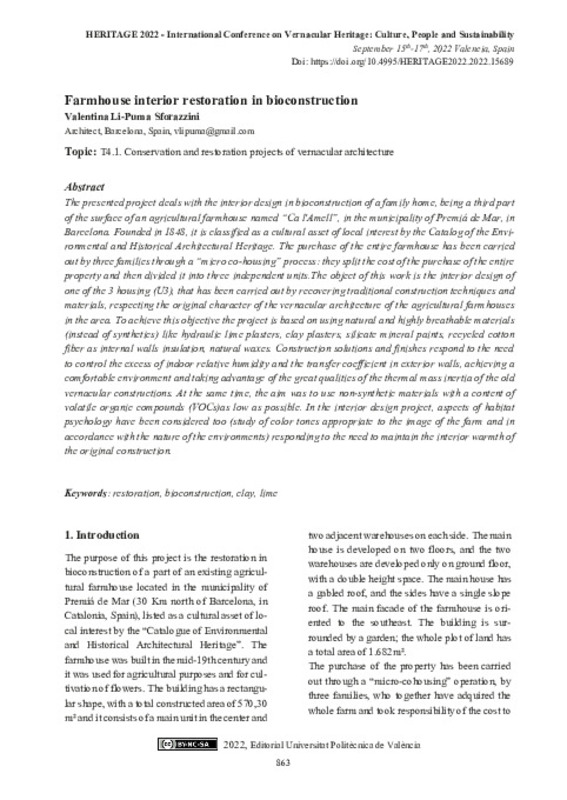JavaScript is disabled for your browser. Some features of this site may not work without it.
Buscar en RiuNet
Listar
Mi cuenta
Estadísticas
Ayuda RiuNet
Admin. UPV
Farmhouse interior restoration in bioconstruction
Mostrar el registro sencillo del ítem
Ficheros en el ítem
| dc.contributor.author | Li Puma Sforazzini, Valentina
|
es_ES |
| dc.date.accessioned | 2022-11-03T10:59:08Z | |
| dc.date.available | 2022-11-03T10:59:08Z | |
| dc.date.issued | 2022-09-13 | |
| dc.identifier.isbn | 9788413960203 | |
| dc.identifier.uri | http://hdl.handle.net/10251/189100 | |
| dc.description.abstract | [EN] The presented project deals with the interior design in bioconstruction of a family home, being a third part of the surface of an agricultural farmhouse named “Ca l'Amell”, in the municipality of Premiá de Mar, in Barcelona. Founded in 1848, it is classified as a cultural asset of local interest by the Catalog of the Environmental and Historical Architectural Heritage. The purchase of the entire farmhouse has been carried out by three families through a “micro co-housing” process: they split the cost of the purchase of the entire property and then divided it into three independent units.The object of this work is the interior design of one of the 3 housing (U3), that has been carried out by recovering traditional construction techniques and materials, respecting the original character of the vernacular architecture of the agricultural farmhouses in the area. To achieve this objective the project is based on using natural and highly breathable materials (instead of synthetics) like hydraulic lime plasters, clay plasters, silicate mineral paints, recycled cotton fiber as internal walls insulation, natural waxes. Construction solutions and finishes respond to the need to control the excess of indoor relative humidity and the transfer coefficient in exterior walls, achieving a comfortable environment and taking advantage of the great qualities of the thermal mass inertia of the old vernacular constructions. At the same time, the aim was to use non-synthetic materials with a content of volatile organic compounds (VOCs)as low as possible. In the interior design project, aspects of habitat psychology have been considered too (study of color tones appropriate to the image of the farm and in accordance with the nature of the environments) responding to the need to maintain the interior warmth of the original construction. | es_ES |
| dc.format.extent | 8 | es_ES |
| dc.language | Inglés | es_ES |
| dc.publisher | Editorial Universitat Politècnica de València | es_ES |
| dc.relation.ispartof | Proceedings HERITAGE 2022 - International Conference on Vernacular Heritage: Culture, People and Sustainability | |
| dc.rights | Reconocimiento - No comercial - Compartir igual (by-nc-sa) | es_ES |
| dc.subject | Restoration | es_ES |
| dc.subject | Bioconstruction | es_ES |
| dc.subject | Clay | es_ES |
| dc.subject | Lime | es_ES |
| dc.title | Farmhouse interior restoration in bioconstruction | es_ES |
| dc.type | Capítulo de libro | es_ES |
| dc.type | Comunicación en congreso | es_ES |
| dc.identifier.doi | 10.4995/HERITAGE2022.2022.15689 | |
| dc.rights.accessRights | Abierto | es_ES |
| dc.description.bibliographicCitation | Li Puma Sforazzini, V. (2022). Farmhouse interior restoration in bioconstruction. En Proceedings HERITAGE 2022 - International Conference on Vernacular Heritage: Culture, People and Sustainability. Editorial Universitat Politècnica de València. 863-870. https://doi.org/10.4995/HERITAGE2022.2022.15689 | es_ES |
| dc.description.accrualMethod | OCS | es_ES |
| dc.relation.conferencename | HERITAGE2022 International Conference on Vernacular Heritage: Culture, People and Sustainability | es_ES |
| dc.relation.conferencedate | Septiembre 15-17, 2022 | es_ES |
| dc.relation.conferenceplace | Valencia, España | es_ES |
| dc.relation.publisherversion | http://ocs.editorial.upv.es/index.php/HERITAGE/HERITAGE2022/paper/view/15689 | es_ES |
| dc.description.upvformatpinicio | 863 | es_ES |
| dc.description.upvformatpfin | 870 | es_ES |
| dc.type.version | info:eu-repo/semantics/publishedVersion | es_ES |
| dc.relation.pasarela | OCS\15689 | es_ES |








